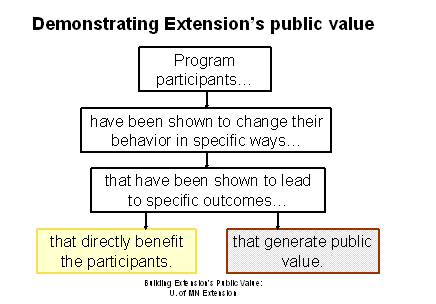The public university’s mission is to…create public value?
Around the country Extension organizations are using the public value approach to make a case for public funding for Extension programs and, in some cases, for the organization as a whole. But, can the public value approach help make a case for public higher education funding, generally? This was–understandably–a topic of conversation yesterday when I taught a short workshop for the Public Higher Education Advocacy Professionals, who held their annual conference here at the University of Minnesota. One answer is that the public value of a state university is the sum of the public value from everything the university does: teaching and granting degrees, outreach education, research, athletics, art performances, continuing education, public engagement, community service, etc. The “public value message” for the university is the [rather thick] catalog of messages for all of the programs in each of these categories.
One answer is that the public value of a state university is the sum of the public value from everything the university does: teaching and granting degrees, outreach education, research, athletics, art performances, continuing education, public engagement, community service, etc. The “public value message” for the university is the [rather thick] catalog of messages for all of the programs in each of these categories.
A more satisfactory answer–and the one I think university advocates are seeking–would convey the public value of the institution in a single, compelling, all-purpose statement. To me, this sounds like a mission statement for the university, with the stipulation that it focus on public value: how the university benefits those who do not have direct contact with the university. The institution’s public value statement answers the question, as if posed by a state resident with no access to university resources, “What are you doing for me?”
A short web search reveals that some public university mission statements already include the answer. Below I excerpted from mission statements the pieces that sounded the most like public value messages:
“[The university’s teaching prepares students] to contribute fully to society as globally engaged citizen leaders…[The university’s research] make[s] make a positive difference, both locally and globally…[The university’s outreach and public engagement] lead to a better quality of life for individuals and communities, at home and around the world.”
“Oregon State University promotes economic, social, cultural and environmental progress for the people of Oregon, the nation and the world.”
“The mission of Kansas State University is to foster excellent teaching, research, and service that develop a highly skilled and educated citizenry necessary to advancing the well-being of Kansas, the nation, and the international community.”
Many public universities see their missions as generally making the state–indeed, the world–a better place. As long as that “betterment” extends to people without direct contact with the university, the institution has accomplished its public value mission, as well.
